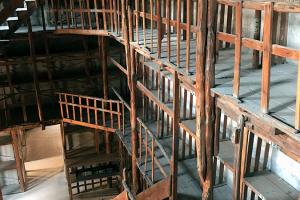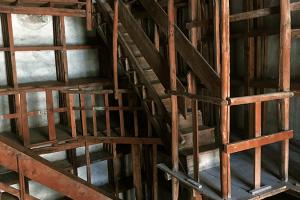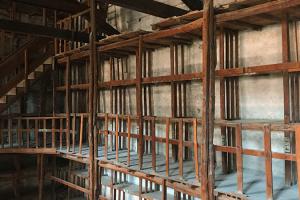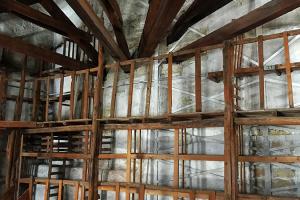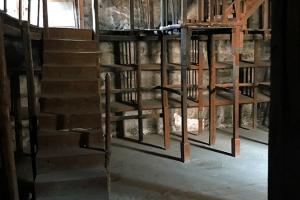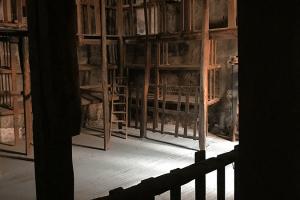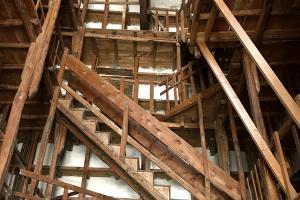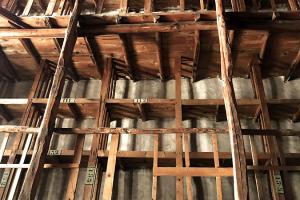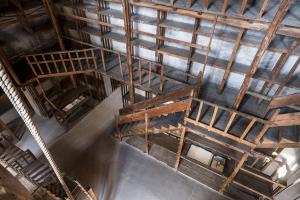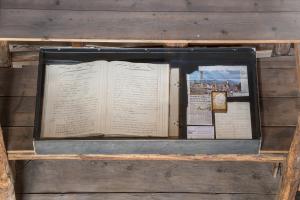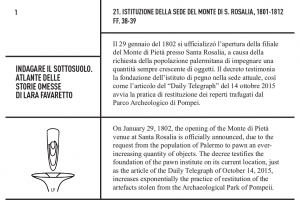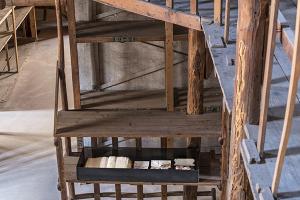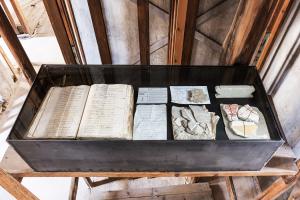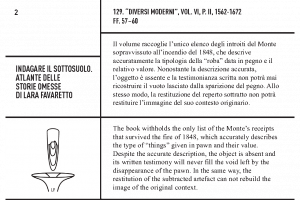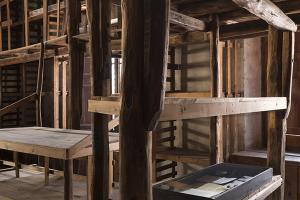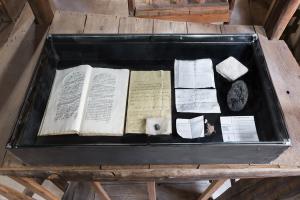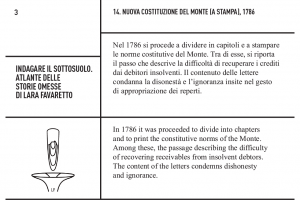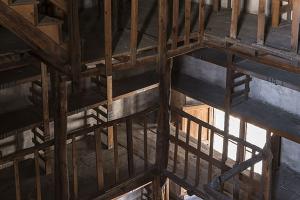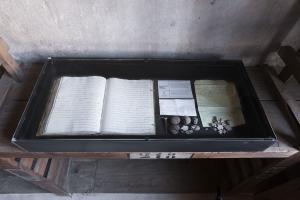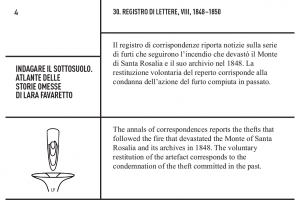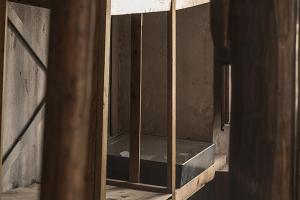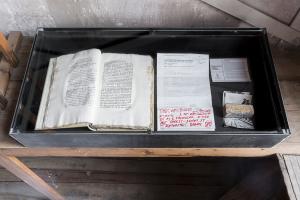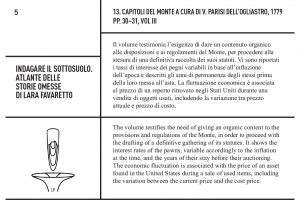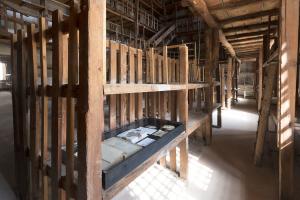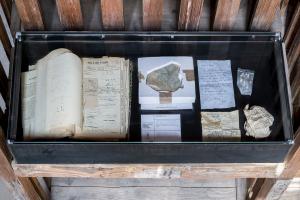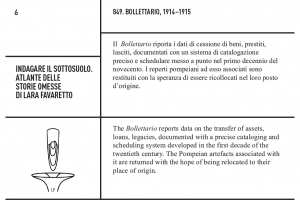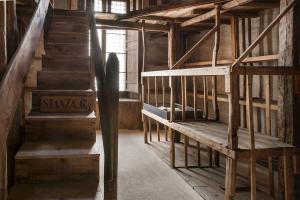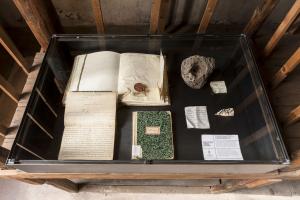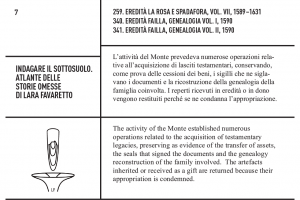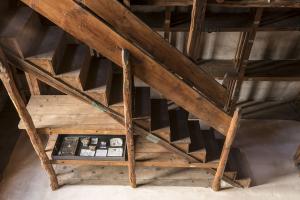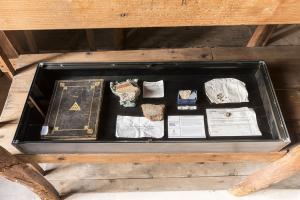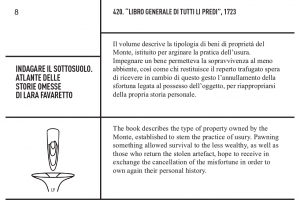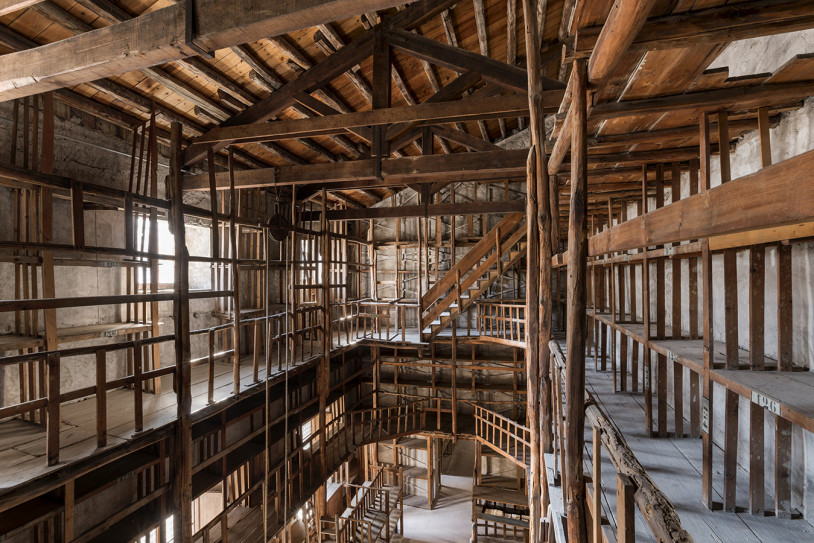
The austere facade of the sixteenth-century Palazzo Branciforte stands out boldly among the alleyways in the old centre of Palermo, amid a series of palaces and churches in sandstone tuff. It was originally a residence created for the luxuries of courtly life, and in it the pomp and splendour of one of the most powerful Sicilian families is intertwined with the fate of the people governed by them: in the early nineteenth century, the building became a branch of the Monte dei Pegni – a loan office to assist the poor – in Palermo.
In the mid-eighteenth century, the Branciforte family obtained a permit to enlarge the building and incorporate the street in front of it, expanding the original structure to include new stables with cross vaults supported by columns of grey marble from Monte di Billemi. The building was later sold to the city’s Senate and transformed into one of the two headquarters of the Monte dei Pegni in Palermo. What made the new premises different from the existing ones was the nature of the assets it contained: the main office, in Via Api, was used for the precious items of the most affluent social classes, while Palazzo Branciforte became a storage site for the few possessions of the lower classes, who were already suffering from the worsening situation of the city’s finances. By 1801, the premises of the headquarters of the Monte di Pietà of Palermo in the Piano della Pannaria area proved to be insufficient for the requirements of the Monte della Pietà per la Pignorazione, which assisted those affected by property seizures. On 23 November, the governor of the Monte therefore asked permission to take over the palazzo of the Prince of Butera in Santa Cita and turn it into the second branch of the Monte, and the institute took it over on 21 December. Between December 1801 and April 1803 the building was renovated and turned into the branch of the Monte dei Pegni, known as the “Monte Santa di Rosalia”, in honour of the patron saint of the city.
From that moment on, the history of Palazzo Branciforte became one of a traumatic collective rift: that of lower-class poverty as the sun set on the great kingdoms. The rooms where Ercole Michele Branciforte – one of the descendants of Don Placido Nicolò Branciforte and Lanza, Count of Raccuja and Prince of Leonforte, who first lived in the palace – had once put on receptions. at which he offered guests sorbets made with five tons of snow brought in from Etna, were filled with rags, old sheets, hats, mattresses, shoes, and threadbare clothes. The Monte di Santa Rosalia became a sort of economic emergency centre for the poor: between 1822 and 1841 about four million seizure orders were issued for linen, silk and woollen items. On 17 January 1848, during the revolutionary uprisings, the building was hit by an incendiary bomb, which caused the roof and the vaults below to collapse, causing serious damage to the roof of the stables. Once the roof of the building had been reconstructed, it was decided not to restore the floor between the first and second storeys but to create large wooden shelving units on which to store the seized goods, cramming them onto numbered shelves. The structure can still be seen, rising from the floor to the ceiling and its various levels are connected by a series of interconnected stairs, balconies and shelves that appear in the dim light of the rooms. The storage assistants were nicknamed “monkey men”: young men of small stature with long, agile limbs, who were selected for their ability to clamber up and move around the shelves as though they were the branches of a tree.
In 1929, the Monte di Pietà merged with the Cassa Centrale di Risparmio Vittorio Emanuele per le Province Siciliane, an institution that for more than fifty years continued with its seizures of non-precious items. In April 1943, at the height of the Second World War, the palazzo was hit during an Allied bombing raid, which destroyed the contents of the storage spaces and the upper loggia on the south side of the main courtyard, as well as part of the building, thus leading to yet another transformation. In 1958, the Cassa di Risparmio incorporated the Fondazione Culturale Lauro Chiazzese, named after its chairman, after his premature death, and Palazzo Branciforte became its headquarters. The building is now owned by Sicilcassa, which entrusted its restoration to the architect Gae Aulenti. Her architectural rationalism is offset by the indefinite, ambiguous and dark history of Bourbon welfarism, which was accompanied here by usury: the miserable amounts obtained from the pawnbrokers were often only enough to repay other debts the poor had contracted with the loan sharks who reigned supreme just outside the walls of the Monte di Santa Rosalia. This is where people were deprived of their assets and faced a tough time just surviving, but also where those same assets changed ownership and their intrinsic meaning consequently underwent a shift in meaning.
The objects that were held at the Monte di Santa Rosalia have now disappeared, for they have been returned, stolen, burnt or dispersed. The gentle rustling of their former existence can be perceived only by reading the ledgers, which are themselves only a simulacrum of the past, in which the meticulous notes left by the clerks convey an abstract, ghostly image of the everyday exchange of objects and identities.
They are like the artefacts “found” by tourists in Pompeii in the nineteenth and twentieth centuries, which were stolen as souvenirs and then returned to the site with a letter, after remorse for a theft that – in some cases – had become seen as a curse. Portions of walls with traces of frescoes have been returned, as have large nails, probably left among the excavations by Bourbon archaeologists, stones, agglomerates of dust, and individual mosaic tesserae detached from the walls. Many such cases have been reported by the media over the years – one example of a report being that of an article in The Daily Telegraph of 14 October 2015, which started the practice of returning finds to Pompeii, and which was one of the documentary materials on which the preparatory research for the exhibition in Palermo was based.
Unlike those collected in the past by the Monte di Santa Rosalia, the “pawns” returned to Pompeii in recent decades are the settlement of a transaction that goes beyond the fluctuations in the economic value of the objects themselves: in this case, it is not the historical and cultural value of the fragment that is at stake in the exchange, but rather the price attributed to it by the conscience of the individual. The act of sending it back to its original location comes from a sense of civic responsibility prompted by superstition or by the idea that its theft jeopardises the conservation not only of the sender but also of the identity of a place that is to some extent defined by it.
The idea of a possible interaction between these stories, which both act through a process of subtraction, led to the project for the exhibition DIGGING UP: ATLAS OF THE BLANK HISTORIES / Indagare il sottosuolo. Atlante delle storie omesse (16-24 June 2018), which was put on, as part of Manifesta 12, at the Palazzo Branciforte, as a prologue and in connection with the presentation of the project at the Villa Arianna (Castellamare di Stabia).
The rooms of the Palazzo Branciforte have countless stories to tell, having witnessed events in which public and private history come together. They convey tacit but allusive testimony to city events and, on this occasion, they became the new custodians of Pompeian finds that have been returned to the archaeological site in recent decades. These fragments come from a different context, from an even more ancient past, and they are filled with impressions and stories, becoming like pawns themselves by being temporarily transferred to the Monte di Pietà in the City of Palermo.
These returned objects were accompanied by the letters that came with them, addressed to the Archaeological Park of Pompeii. These side-stories were displayed together with a selection of historical books dating from 1560 to 1950 on the work of the Monte di Pietà in Palermo. The work and even the very identity of the Monte in Palermo and, in particular, the thread of forgotten stories that piled up on the shelves of the Monte dei Pegni di Santa Rosalia, the documentation of which was lost in the fire of 1848, emerged from a setting bereft of its pawns, but whose ledgers meticulously document its activities and reconstruct its official history. The association between these historic volumes and the selection of letters and objects from Pompeii was illustrated by an investigation of extracts from each text, which are all linked to testimonies of events, pointing to an erased timeline that the project attempted to recover.
The volumes on display included one that contains the only list of the Monte’s receipts to have survived the fire of 1848 (129. “Diversi moderni”, vol. VI, P. II, 1562-1672). This register contains a precise description of the roba – the “stuff” – that was pawned, thus handing down an ekphrasis of objects that will be forever missing. This was matched by a whole array of artefacts stolen from Pompeii and then returned, but since these have been removed from their original setting, they will remain as fragments that are forever out of place. The Libro generale di tutti li predi (1723), on the other hand, upholds the role of the Monte in clamping down on usury, ensuring that the poor could live in dignity and giving them a means of redemption. This was paired with the letters that accompanied the return of the archaeological finds to Pompeii, which were written in the hope of warding off the ill-luck brought on by possession of the objects, evoking the idea of an exchange on an immaterial level.
The void left by the stolen object, which will never be able to return to its rightful place, like that of the pawned object that will never be returned to its owner or even to the place that had become its home, constitute the primary story, which is that of exploring alternative narratives that act as time machines. The aim is to reconstruct a fragment that has been omitted from the historical memory of Palermo, just as the Time Capsule that ends the Pompeii project attempts to reconstruct that of Roman and present-day Pompeii.





